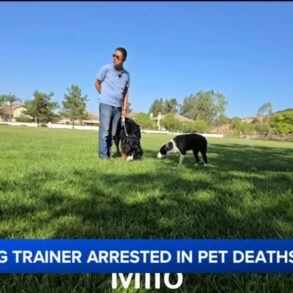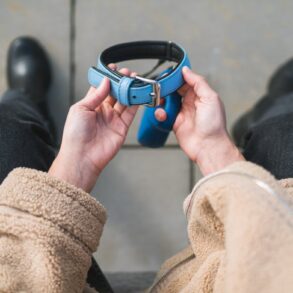
Photograph courtesy Children’s Hospital Canine Comfort Facility Dog Program
“Our dog has definitely changed our life.” It’s a common sentiment that many of us who’ve opened our lives and homes to a pet can share. The calming touch of a cool nose on a warm day, the nuzzle of a fuzzy muzzle, that floppy tail, lolling tongue and happy stare—dogs provide the calming presence of an unjudging defender in a chaotic world and that, for anybody, can be deeply life-changing.
Kathy Barnes, however, is talking about her son’s service dog, Mimosa, a 6-year-old goldendoodle partnered with the 18-year-old Kings High School student. And in some very significant ways, Mimosa has radically transformed the South Lebanon family’s life for the better.
“She goes to school with J.J. every day,” Barnes says. “She sleeps with him every night. She does retrieval for him, pressure, she can open doors. He’s in a wheelchair, so it’s really helpful. Like, if you have your hands full and he drops a toy on the floor, she’ll pick it up and put it back in his lap. She can turn on lights. She can open handicapped doors for us. It’s like having an extra hand.”
Beyond helping out with everyday tasks, Mimosa brings calm and social benefits to J.J. when he goes about his day. “He definitely functions better than if, for some reason, she’s not at school one day,” explains Barnes. “He’s calmer and just more acclimated when she’s around.”
This was exactly the desired outcome when 4 Paws for Ability placed the service dog with J.J. in late 2020. And that magical moment when Mimosa was partnered with the Barnes family was, as you might imagine, the result of a long and specialized training process.

Photograph courtesy 4 Paws For Ability
“Our process starts even before the dogs are born,” says Jennifer Lutes, executive director of the program. “We have a breeding program that includes dogs who have passed thorough health and behavior qualifications. These include genetic testing, cardiology testing, orthopedic testing, and more.”
4 Paws for Ability was started in 1998 by founder Karen Shirk as a grassroots organization functioning out of a one-bedroom apartment. The program now operates from a purpose-built campus in Xenia and currently places around 120 dogs a year with children and veterans who have disabilities. At any point, according to Lutes, 4 Paws has around 400 dogs somewhere along the path of pup to placement and is this year, in fact, celebrating the placement of its 2,000th animal.
“Puppies born to the breeder dogs are raised in our Puppy Enrichment Program,” she explains. “This starts at just three days old and lays the foundation of the rest of the training. As the puppies grow in the program, they grow in skills in areas related to manners, obedience and public practice.”
This is a critical stage, says Marlys Staley, executive director of Circle Tail, Inc. in Pleasant Plain. A trained physical therapist, Staley founded Circle Tail in 1997 as a way to extend her capacity for bringing more independence to the lives of people with limitations, training service dogs for mobility and hearing assistance as well as diabetes alert.
“The first part of a puppy’s life, they need to be a puppy,” she explains. “But you’re always thinking of manners and self-control. It’s a little bit different than with a pet dog, because they’re going to go on to be working dogs. You have to do a lot of socialization and make sure that sights don’t bother them, sounds don’t bother them, smells don’t bother them, people don’t bother them, dogs don’t bother them.” Circle Tail also trains facility dogs to place in schools, where sensory stimulation can be especially high.
Staley explains that basic obedience training (“which all good dogs should have anyway,” she says, adding that Circle Tail also offers low-cost training as a community service), with skill-specific training layered in to teach dogs abilities such as object retrieval, hearing assistance and other disability-specific services. At 4 Paws, says Lutes, the service dog is evaluated at around one year to determine if they’re ready for this advanced training.

All in all, the lengthy training at both organizations will see dogs rotating between the homes of foster families, prison programs, and on-site residency. The intensive program is designed to ensure the animal is demonstrably ready to begin working as a service animal. “We want to make sure that we have any behavior issues in the dog ironed out and the dog we see is the dog,” explains Staley. “So it’s about a two-year training process, with socialization and a variety of experiences throughout the whole time, then layering on the obedience.”
After this years-long process, an animal is finally deemed ready to team with a human. At 4 Paws for Ability, this means 10 days of on-site training for the dog’s new human to learn how to handle and live with the service animal. “We always say that the dog’s the easier one to train,” laughs Staley. “It’s the human that’s the more difficult one.”
She stresses that partnering an animal with its human is just the beginning of the work Circle Tail does with the dog-and-human team. “We follow them through the life of a team. We make sure that if anything comes up, anything changes—health challenges, different task needs, training for those things—we follow with our team the whole way through.”

As two of only a limited number of service dog training programs in the Cincinnati area, both 4 Paws for Ability and Circle Tail are committed to supplying service dogs to local individuals who can use a helping paw. Circle Tail, which raises between 15 and 20 dogs a year for either service work or as facility animals, only partners with individuals within a 90-mile radius of Cincinnati. 4 Paws for Ability will provide animals for some individuals farther away.
“About 25 percent of our service dog placements go to homes that are within a few hours of 4 Paws,” explains Lutes. “But due to the specialized training we provide in scent work for children with seizures and autism, we have individuals travel from all over the country to receive a 4 Paws service dog.”
Training and providing service dogs to local families is truly special work, impacting the daily lives of individuals who could use a little bit of help. “I can’t say enough about an organization that does all this to help families out,” says Barnes, pointing to Mimosa. “It is life-changing for a family.”
These Animals Bring Cuddly Comfort

Photograph courtesy Children’s Hospital Canine Comfort Facility Dog Program
While service dogs lend a helping hand … er, paw to those with persistent limitations, there’s another set of working dogs out there giving folks emotional support during trying times—therapy and facility dogs.
Child Life Specialist Kerri Birkett has seen animals’ calming effects many times as the facility dog handler of a pup named Leica for the Children’s Hospital Canine Comfort Facility Dog Program. “Healthcare visits are stressful for patients and their caregivers, and Leica supports patients with disabilities who have difficulties coping with their visit,” she says. “Leica’s presence, love, and comfort, helps create a safe and supportive environment for patients to receive necessary medical care.”
The program uses dogs from Canine Assistants and Canine Companions, two service dog programs that also place facility dogs.
“You just see the difference that sharing your animal can make with people,” says Susan Steinhardt, executive director of Pet Partners of Greater Cincinnati, an all-volunteer organization that provides handler workshops and licensed evaluation to certify animal-handler teams of dogs and eight other animal species, including cats, rabbits, and even pot-belly pigs. The organization also works with hospices, schools and universities, libraries and even businesses, and has programs for first responder and crisis response support teams.

Photograph courtesy Pet Partners of Greater Cincinnati
To get their pet and themselves involved with Pet Partners, volunteers need to complete training focusing on policies and procedures for the handler, and the animal also needs confirmation from a veterinarian for vaccination status and general health. There’s also an evaluation of the handler-dog team to test the dog’s temperament in a variety of potential scenarios, as well as the handler’s attitude with the animal. Following a background check from the national Pet Partners organization, the volunteer will undergo a mentorship, then the team is certified and ready to go out on visits. “We have more visit requests than we can handle,” Steinhardt says. “We would like to get to 200 members by next July. And that still may not be enough!”
This post was originally published on this site be sure to check out more of their content.













































